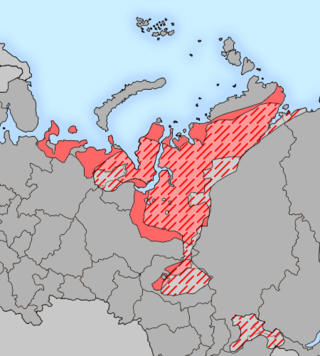Top Qs
Timeline
Chat
Perspective
Samoyedic peoples
Ethnolinguistic group indigenous to Siberia, Russia From Wikipedia, the free encyclopedia
Remove ads
The Samoyedic peoples (sometimes Samodeic peoples)[a] are a group of closely related peoples who speak Samoyedic languages, which are part of the Uralic family. They are a linguistic, ethnic, and cultural grouping. The name derives from the obsolete term Samoyed used in Russian Empire for some of the indigenous peoples of Siberia, see Samoyedic languages#Etymology for comments of the etymology.

Remove ads
Peoples
Contemporary
Extinct
Remove ads
Classification
Traditionally, Samoyedic languages and peoples have been divided into two major areal groups: Northern Samoyedic (Nenets, Yurats, Enets, Nganasans), and Southern Samoyedic (Selkups) with a further subgroup of Sayan-Samoyedic (Kamasins, Mators) named after the Sayan Mountains. This classification does not reflect linguistic relations, being purely geographical.
The most numerous of the Samoyedic peoples are the Nenets, who mainly live in two autonomous districts of Russia: Yamalo-Nenetsia and Nenetsia. Some of the Nenets and most of the Enets and Nganasans used to live in the Taymyrsky Dolgano-Nenetsky District. Most of the Selkups live in Yamalo-Nenetsia, but there is also a significant population in Tomsk Oblast.
Remove ads
Gallery
Historical pictures
- Samoyed in summer dress, in 1781, by Johann Gottlieb Georgi
- Samoyed in 1781 by Johann Gottlieb Georgi
- Habit of a Samoyed woman and child in 1768, by Jean-Baptiste Chappe d'Auteroche[4]
- Samoyed winter dress (before 1906)
- A reindeer herd in Kolguyev Island in 1895.
Modern
- Yenisei Samoyedes (Enets people) around a campfire (1914)
- Nganasans, 1927
- Nganasan folkloric group, 2018
- Nenets group, 1913
- Nenets family
- Nenets children, 2016
- Northern Selkups, 2012
- Kamasin family, 1925
See also
Notes
- Some ethnologists use the term 'Samodeic peoples' instead 'Samoyedic', see Balzer, Marjorie (1999). The Tenacity of Ethnicity. Princeton University Press. p. 241. ISBN 978-0-691-00673-4.
References
External links
Wikiwand - on
Seamless Wikipedia browsing. On steroids.
Remove ads













